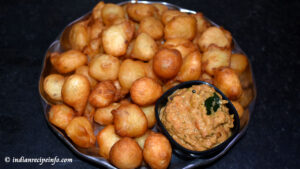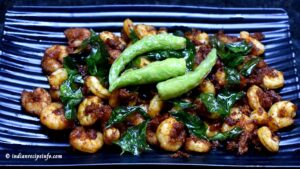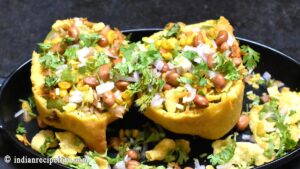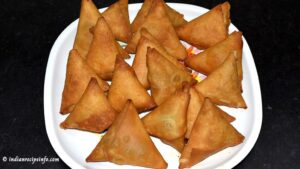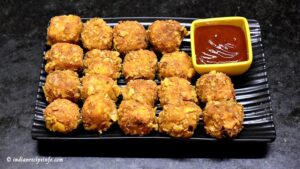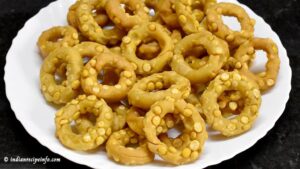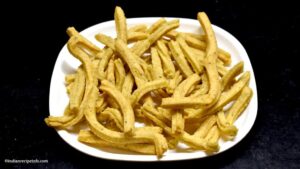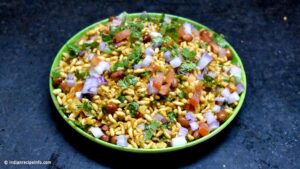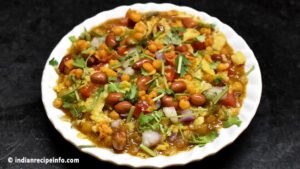Sweet Corn Samosa Recipe is one of the popular snacks in India. It is made with a flaky pastry dough filled with a mixture of sweet corn, potatoes, spices, and herbs. Learn how to make sweet corn samosa recipe with our step by step image instructions along with pro tips.
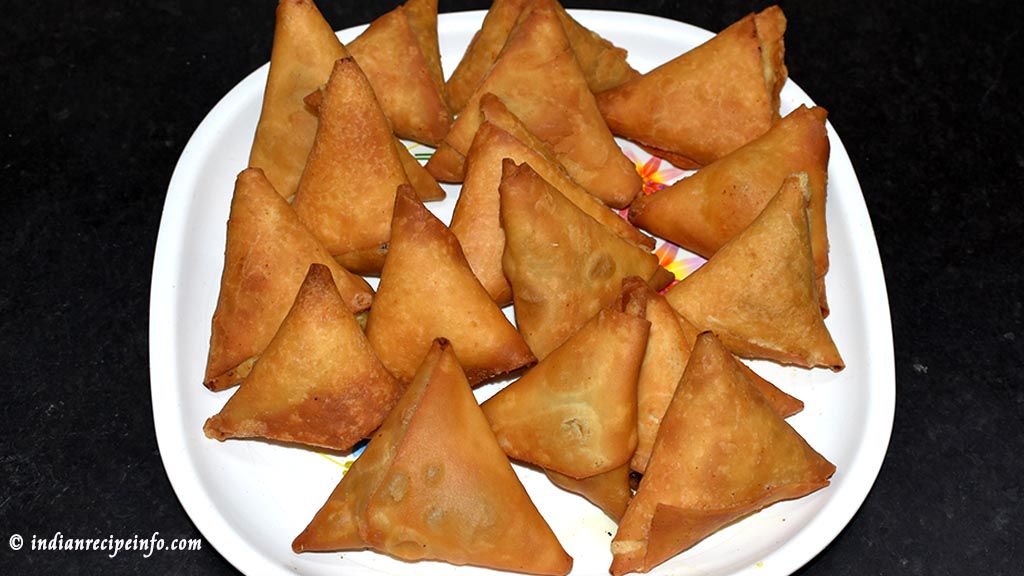
About Sweet Corn Samosa Recipe
Sweet corn samosas are a delightful variation of the traditional savory samosas that are popular in Indian cuisine. While traditional samosas are typically filled with spiced potatoes, peas, and sometimes meat, sweet corn samosas have a filling made with a mixture of sweet corn kernels and a blend of spices, creating a unique sweet and savory combination.
Here’s a general idea of how sweet corn samosas are prepared:
- Filling Preparation: The filling for sweet corn samosas starts with cooking sweet corn kernels. These can be fresh, frozen, or canned corn kernels. The corn is usually sautéed with a mixture of spices like cumin, coriander, garam masala, and sometimes a touch of red chili powder for heat. Some variations might also include ingredients like finely chopped onions, green chilies, and ginger for added flavor. The filling is then allowed to cool before using it to fill the samosa pastry.
- Samosa Pastry: The samosa pastry is typically made from all-purpose flour, water, and a bit of oil. The dough is kneaded until smooth and pliable, then rolled out into thin sheets. These sheets are usually cut into triangles or rectangles, depending on the desired size of the samosas.
- Filling and Folding: A portion of the sweet corn filling is placed in the center of each pastry sheet. The pastry is then folded over the filling to create a triangle shape. The edges are sealed by brushing a flour-water paste along the edges and pressing them together.
- Frying: The filled and sealed sweet corn samosas are deep-fried until they become golden brown and crispy. The frying process gives the samosas their signature crunchy texture.
- Serving: Sweet corn samosas are often served hot as a snack or appetizer. They are commonly accompanied by mint chutney, tamarind chutney, or even a yogurt-based dip for added flavor.
Here are a few finger-licking recipes:
Sweet corn Vada and
How to make sweet corn samosa recipe:
1. First let’s prepare filling, heat a pan and put a little oil, cumin seeds, minced green chiles and curry leaves.
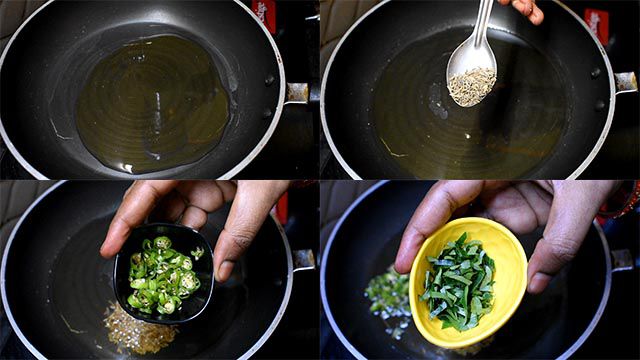
2. Add onions, sweet corn, salt and a pinch of turmeric powder.
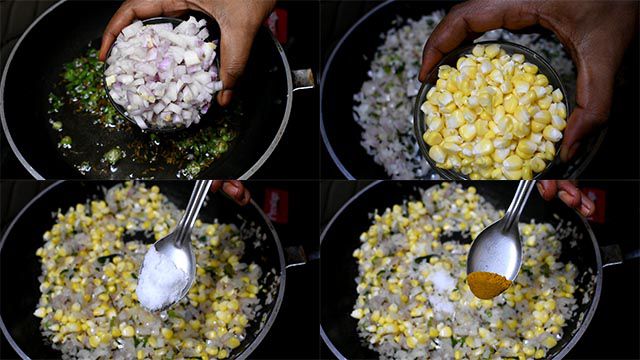
3. Sprinkle red chili powder, chaat masala powder and garam masala powder. Close the lid and cook for 5 minutes.
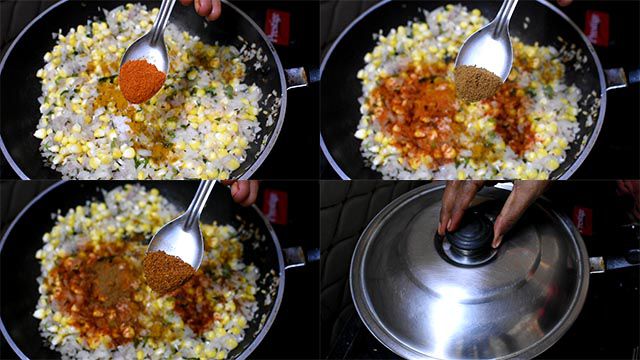
4. Once cooked, sprinkle coriander leaves and keep aside to cool.
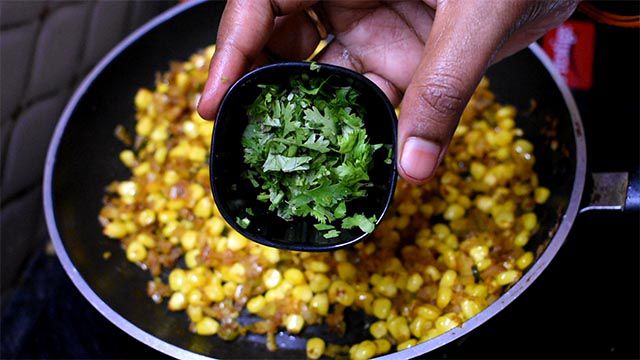
5. Put all-purpose flour in a mixing bowl, add ½ tbsp. salt, 1 large spoon of oil and a little water.
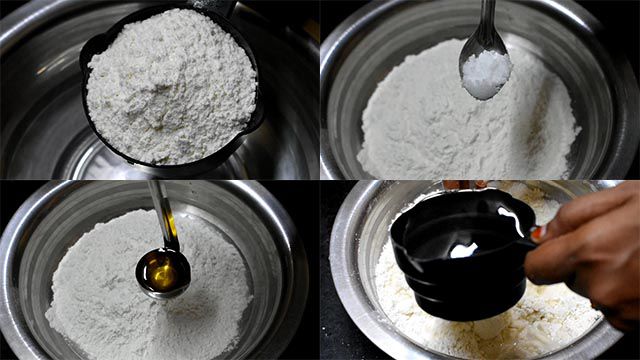
6. Knead well keeping dough tight. Roll to form a long cylindrical shape.
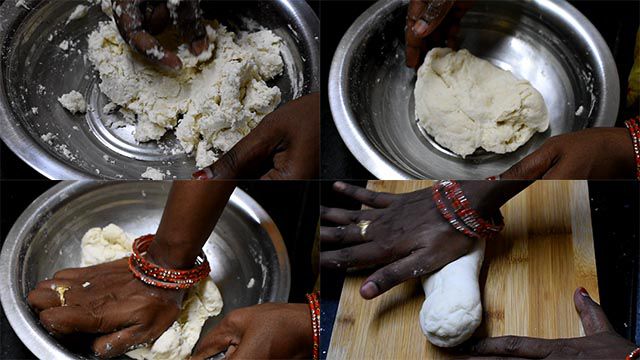
7. Now cut down into small pieces and make them round balls. Keep aside.
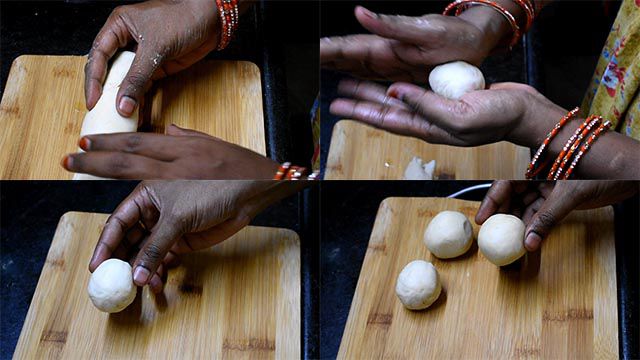
8. Put a little flour on the surface and apply this flour to both sides of the dough ball.

9. Roll dough to form a thin and round cylindrical shape. On the other hand, heat the pan and cook mildly for a few seconds.
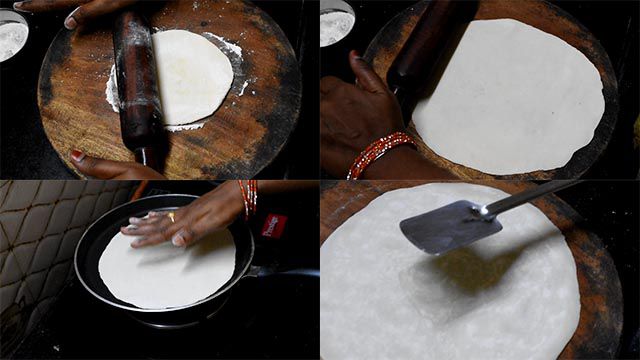
10. Slice chapati on the edges to form a square shape as shown in the picture. Cut into three slices to form a rectangular shape.
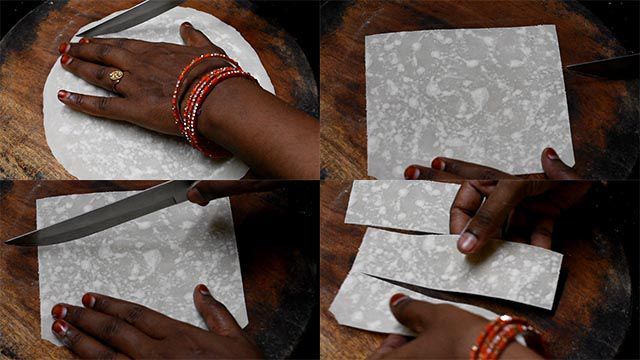
11. Put 2-3 tbsp. of all-purpose flour in a bowl and pour a little water to make a thick paste.

12. Fold the maida wrapper into a cone shape as shown in the picture and fill it with corn mix.
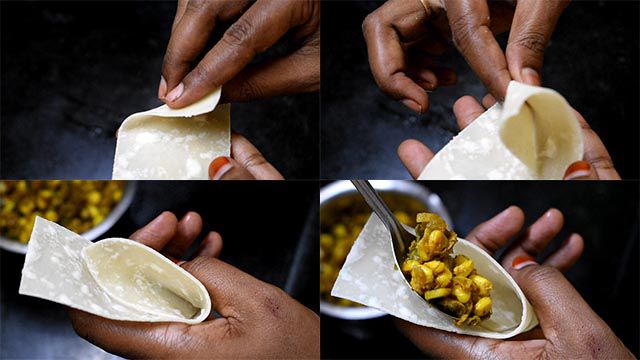
13. Apply maida concentration to the edges of the wrapper. Seal the wrapper to form a triangle shape, and keep it aside. Similarly make remaining samosas.
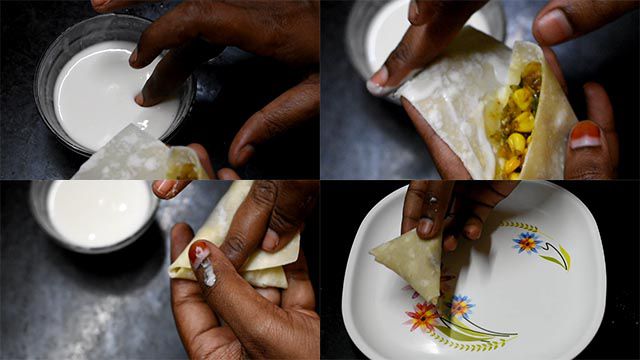
14. Heat oil in a pan and put sweet corn samosa and deep fry. Flip to the other side to fry till golden brown color. Once fried, remove the sweet corn samosa recipe from the oil and transfer them to another plate. Serve hot.
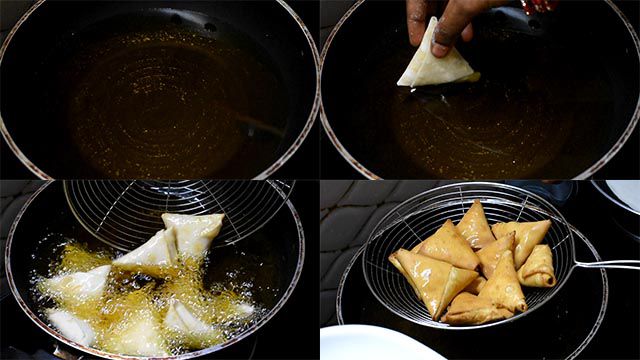
Watch sweet corn samosa recipe video on >> YouTube.
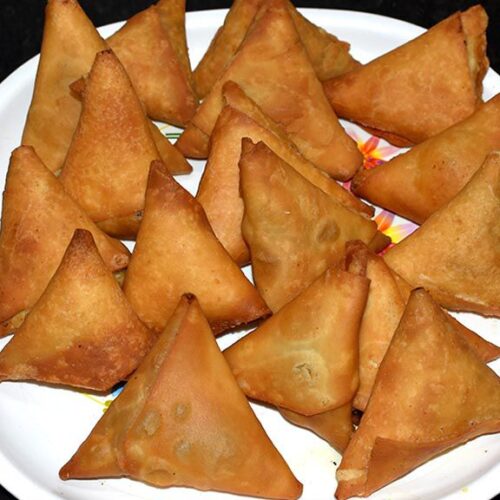
Sweet Corn Samosa Recipe Card
Sweetcorn samosa is a popular snack in India, Pakistan, and Bangladesh. It is made with a flaky pastry dough filled with a mixture of sweet corn, potatoes, spices, and herbs.
Ingredients
- Sweet Corn – 1 cup
- Maida/ all purpose flour – 2 cups
- Cumin seeds – ½ tbsp.
- Green chilies – 1 tbsp. minced
- Curry leaves – 1 tbsp. minced
- Onions – 1 cup
- Salt – 1 tbsp.
- Turmeric powder – a pinch
- Red chili powder – ½ tbsp.
- Chaat masala powder – ½ tbsp.
- Garam masala powder – ½ tbsp.
- Coriander leaves – 1 tbsp.
- Water – 1 cup to knead
- Oil – to deep fry
Instructions
- To begin, heat a skillet and add a little oil, cumin seeds, minced green chilies, and curry leaves.
- Stir in the onions, sweet corn, salt and turmeric powder.
- Add red chilli powder, chaat masala powder, and garam masala powder to taste. Cook for 5 minutes with the lid closed.
- When finished, sprinkle with coriander leaves and set aside to cool.
- In a mixing bowl, combine all-purpose flour, 12 tbsp salt, 1 large spoon oil, and a little water.
- Knead the dough thoroughly while keeping it tight. Form a long cylindrical shape by rolling.
- Cut into small pieces and shape into spherical balls. Set aside.
- Sprinkle a little flour on the board and coat both sides of the dough ball.
- Roll the dough into a thin, round cylindrical shape. Cook for a few seconds on the other side of the pan.
- Cut the chapati into squares along the edges, as shown in the picture. Cut into three slices to form a rectangle.
- In a mixing bowl, combine 2-3 tablespoons all-purpose flour and a little water to produce a thick paste.
- Fold the maida wrapper into a cone form, as shown in the picture, and fill with the corn mixture and close the wrapper with the help of all-purpose flour paste.
- Heat oil in a skillet and deep fry sweet corn samosas. Fry until golden brown on the other side. Remove from the oil and set aside.
Recipe Video
Recipe Notes
Here are some tips for making sweet corn samosas:
- Use fresh sweet corn kernels for the best flavor.
- Don’t overcook the potatoes, or they will become mushy.
- Season the filling to your liking.
- Use a deep-frying thermometer to ensure that the oil is at the correct temperature.
- Fry the samosas in batches to prevent them from sticking together.
- Drain the samosas on paper towels to remove excess oil.
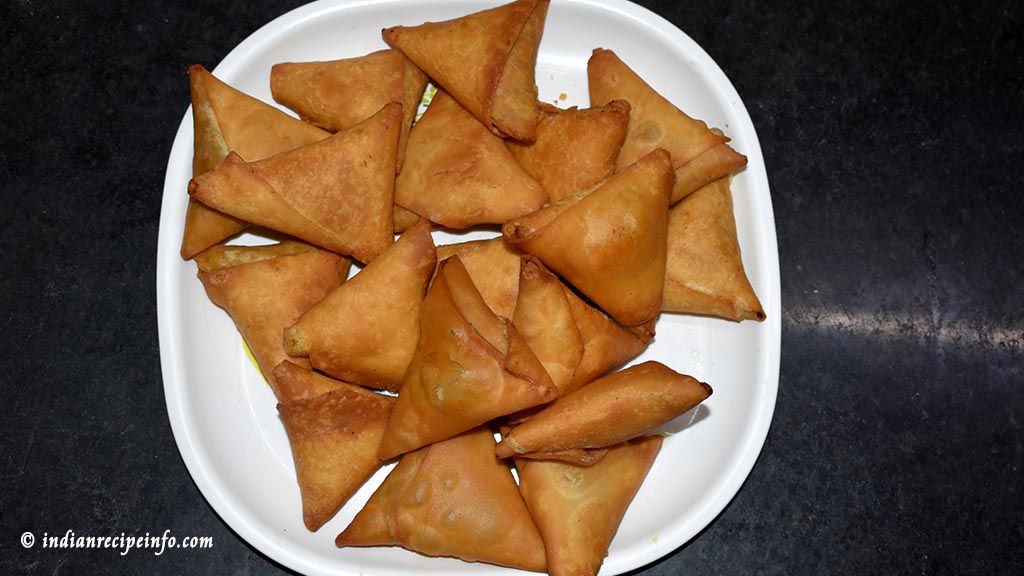
Pro-Tips to Make Sweet Corn Samosa Recipe:
Filling preparation: Start by cooking the sweet corn kernels until they are tender. You can use fresh or frozen corn kernels. Once cooked, drain any excess water and set aside.
Flavorful spice mix: Prepare a spice mixture by combining turmeric powder, red chili powder, garam masala powder, and chaat masala powder. Adjust the spice levels according to your taste preferences.
Sautéing the filling: Heat oil in a pan and add finely chopped onions. Sauté them until they turn translucent. Then, add ginger-garlic paste and finely chopped green chilies. Sauté for a minute or until the raw aroma of the ginger-garlic paste dissipates.
Adding spices: Add the prepared spice mixture to the pan and mix well with the onion mixture. Allow the spices to cook for a minute to release their flavors.
Incorporating corn kernels: Add the cooked sweet corn kernels to the pan and mix them with the spice-onion mixture. Stir well to ensure the corn kernels are coated evenly with the spices. Cook the mixture for a few minutes to let the flavors meld together.
Seasoning and garnishing: Season the corn filling with salt to taste and add fresh coriander leaves for a burst of freshness and flavor. Mix well and turn off the heat.
Samosa assembly: Take samosa wrappers or pastry sheets and cut them into triangles or rectangles. Place a spoonful of the sweet corn filling in the center of each wrapper. Fold the wrapper over the filling to form a triangle or cone shape. Seal the edges with a flour paste made from all-purpose flour and water.
Frying the samosas: Heat oil in a deep pan or fryer. Carefully add the samosas into the hot oil and fry them until they turn golden brown and crispy. Fry them in small batches to ensure even cooking.
Serve and enjoy: Once the samosas are fried, remove them from the oil and place them on paper towels to drain excess oil. Serve the sweet corn samosas hot with chutneys or sauces of your choice.
Remember to exercise caution when working with hot oil and always follow proper safety procedures while frying. Enjoy your homemade sweet corn samosas!
FAQ:
Why my samosa is not crispy?
Here are some possible reasons and tips to help you achieve that perfect crispy texture:
- Temperature of Oil: The oil temperature plays a crucial role in achieving crispy samosas. If the oil is not hot enough, the samosas will absorb more oil and become soggy. Make sure the oil is at the right temperature, usually around 350-375°F (175-190°C), before frying the samosas.
- Oil Quality: The type and quality of oil you use can impact the crispiness. Choose oils with a high smoke point, such as vegetable oil or canola oil. Oils with low smoke points can break down and result in soggy samosas.
- Overcrowding the Pan: Frying too many samosas at once can lower the temperature of the oil and lead to uneven cooking. Fry the samosas in batches, ensuring there’s enough space between them in the pan.
- Thickness of Dough: If the dough of the samosas is too thick, it might prevent them from becoming crispy. Roll out the dough as thinly as possible while still being manageable to work with.
- Sealing Properly: If the samosas aren’t sealed well, oil can seep into the filling and make them soggy. Make sure you seal the edges of the samosas securely using a flour-water paste.
- Draining Excess Oil: After frying, place the cooked samosas on a paper towel-lined plate to drain excess oil. This helps in maintaining their crispiness.
- Reheating: If you’re reheating samosas, using an oven or toaster oven is preferable over a microwave. Microwaving can make them lose their crispness.
- Frying Time: Ensure that the samosas are fried until they are a deep golden brown color. Undercooked samosas might not be crispy.
- Freshness of Ingredients: Using fresh ingredients for the filling and dough can contribute to better texture. If the filling is too moist, it can lead to soggy samosas.
- Preventing Steam: If the filling is too moist or contains excess water, it can create steam inside the samosas, making them less crispy. Make sure to cook and drain ingredients like vegetables before using them in the filling.
What is a dirty samosa?
The term “dirty samosa” is a slang term for a samosa that is made with low-quality ingredients or that is not prepared hygienically. It can also refer to a samosa that is sold by street vendors or in unsanitary conditions.
The term is not meant to be derogatory, but rather to warn people about the potential health risks of eating such a samosa. Dirty samosas may contain harmful bacteria or other contaminants, which can cause food poisoning.
If you are unsure about the quality or cleanliness of a samosa, it is best to avoid eating it. There are many other delicious and safe samosas available, so there is no need to take the risk.
What is the best type of samosa?
The “best” type of samosa can vary widely depending on personal taste preferences and regional cuisines. Samosas come in various fillings, shapes, and sizes, each with its own unique flavors and characteristics. Here are some popular types of samosas enjoyed in different parts of the world:
- Potato and Pea Samosa: This is one of the most traditional and widely recognized types of samosas. The filling consists of spiced mashed potatoes and peas. It’s a classic choice and often served as a snack or appetizer.
- Vegetable Samosa: In addition to potatoes and peas, vegetable samosas can include a mix of finely chopped or grated vegetables such as carrots, beans, and bell peppers. The combination of veggies adds extra flavor and texture.
- Paneer (Indian Cheese) Samosa: Paneer samosas are filled with a mixture of crumbled paneer (Indian cottage cheese), spices, and sometimes peas. This variation offers a creamy and slightly tangy taste.
- Keema Samosa: This type of samosa contains a filling of spiced minced meat, usually chicken, beef, or lamb. It’s popular in many South Asian cuisines and offers a savory and hearty option.
- Sweet Samosas: As discussed earlier, sweet samosas are a delightful twist on the savory version. They can have fillings like sweetened coconut, jaggery, nuts, and fruits, often seasoned with spices like cardamom.
- Cheese and Spinach Samosa: This is a fusion variation where the filling consists of a mix of sautéed spinach and cheese, like feta or ricotta. It’s a fusion of flavors from various cuisines.
- Punjabi Samosa: A larger version of the classic samosa, Punjabi samosas are known for their generous filling and flaky exterior. They often have a spicier filling and are enjoyed with chutneys.
- Aloo Tikki Samosa: This innovative version includes a potato tikki (patty) as the filling, giving the samosa a unique texture and flavor.
- Seafood Samosa: In coastal regions, you might find samosas with seafood fillings, such as shrimp or fish, seasoned with coastal spices.
- Fusion Samosas: With global culinary influences, fusion samosas have emerged, featuring non-traditional fillings like pizza, taco, or even chocolate.
Why samosa is junk food?
Samosas are often considered as “junk food” due to their high calorie and fat content, as well as their deep-fried preparation method. While they are undeniably delicious and a popular snack in many cultures, several factors contribute to their classification as junk food:
- High Calorie and Fat Content: Samosas are typically deep-fried, which leads to absorption of oil and significantly increases their calorie and fat content. The pastry used for the outer shell is often made with refined flour, which contributes to the calorie count.
- Low Nutritional Value: Traditional samosas often lack substantial nutritional value. While they might contain some vegetables or protein in the filling, the deep-frying process can diminish the nutrient content. They are often not a well-balanced meal or snack in terms of vitamins, minerals, and fiber.
- Unhealthy Cooking Method: Deep frying is considered an unhealthy cooking method due to the high temperatures and the potential for oil to be absorbed into the food, resulting in excess calories and unhealthy fats.
- Portion Control: Samosas are typically quite small and can be eaten quickly, leading to overeating and consuming more calories than intended.
- Lack of Essential Nutrients: Junk food is often defined by its lack of essential nutrients. While samosas can offer carbohydrates and some protein, they often lack the vitamins, minerals, and other nutrients that are essential for a balanced diet.
- Added Salt and Spices: The fillings of samosas are often heavily spiced and can contain high amounts of salt, which can contribute to health issues such as high blood pressure when consumed in excess.
Is samosa sweet or savory?
Samosas are typically savory snacks, but there are also sweet variations available. The traditional and most common type of samosa is savory, filled with spiced ingredients such as potatoes, peas, lentils, meat, or paneer (Indian cheese). These savory samosas are often seasoned with a blend of spices like cumin, coriander, and garam masala to create a flavorful and aromatic filling.
However, there are sweet samosas as well, where the filling is composed of sweet ingredients. Sweet samosas can include fillings made from sweetened coconut, jaggery (a type of unrefined sugar), nuts, dried fruits, and sometimes even sweetened khoya (a type of evaporated milk solids). These sweet samosas are less common than their savory counterparts but offer a unique dessert-like treat.
